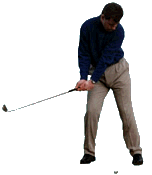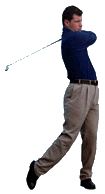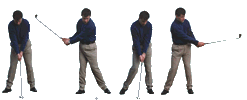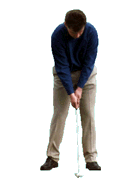The first thing to remember about the golf swing is that power and distance
come from the coiling motion of the upper body and not brute force. The best
golfers have a smooth and consistent swing and this should be every golfer's
goal. The golf swing is actually broken into the three categories namely the
short, medium and long (full) swing. This article focuses on the full swing
however the other two are also explained.
There are five stages to the golf swing - address, take away, back swing,
down swing and the follow through. These are explained in detail below.
Remember to maintain posture throughout and focus on the coiling motion of the
upper body and the movement of the feet. Keep your eye on the ball at all
times.
The Long / Full Swing
Address
To address the ball is to assume the correct stance and posture
and bring the clubhead to the ball. Previous sections in 'The Golf Pro' cover
these topics. They are deceptively straightforward but constitute the
foundation of your golf swing. Their importance therefore cannot be
over-stressed.
 Take
Away
Take
Away
The takeaway is the first part of the backswing. The club is brought
parallel to the ground simply by moving the shoulders alone. Hands and arms
remain in the same relative positions as when at address. Weight is transferred
to the right leg as the left foot lifts at the heel.
 Backswing
Backswing
The backswing compresses the coil which is the body. The clubhead
is brought over the head as the hands extend to shoulder height. Only at the
top of the backswing should the wrists be cocked. This action will naturally
bring the shoulders through a 90 deg arc and the hips through a 45 deg arc.
Weight is almost entirely transferred to the right leg. The left leg will only
be touching the ground with the ball of the foot.
Downswing

The
downswing is that part of the swing from the top of the backswing to the point
of impact with the ball. It uncoils the body and releases it's potential
energy. The action is driven by the unwinding of the hips. The upper body and
legs follow the hips and weight is transferred from right to left. Only during
the later stages are the arms once again extended and the wrists uncocked. This
is a natural rather than a forced movement should therefore not be a matter of
having to remember it.
As the club impacts the ball you should not find yourself in the address
position but slightly balanced more on our left side.
Follow Through
The follow through is that part of the swing during and after
impact with the ball. The body uncoils fully with the right hip and shoulder
pointing at the ball's original position and body facing down the target line.
The arms follow through to bring the clubhead around the back of the head.
 The
important part of the follow-through is that the clubhead momentarily pulls the
ball along the target line. Previous stages provide the power while this stage
provides guidance. While the clubhead is in contact with the ball it must move
along the target line. If the clubhead moves from out to in or vice versa, the
ball will be either pulled to the left or pushed to the right. If your divots
point straight down the target line then you can assume that your
follow-through is correct.
The
important part of the follow-through is that the clubhead momentarily pulls the
ball along the target line. Previous stages provide the power while this stage
provides guidance. While the clubhead is in contact with the ball it must move
along the target line. If the clubhead moves from out to in or vice versa, the
ball will be either pulled to the left or pushed to the right. If your divots
point straight down the target line then you can assume that your
follow-through is correct.
The Medium Swing
The medium swing lends itself to pitching, that is shots of around 50
yards using a highly lofted iron or perhaps pitching wedge. The idea is for the
ball to travel with a high trajectory causing minimal roll on impact or perhaps
to clear obstacles.
The main difference between the medium swing and the full swing is in the
degree of the backswing ,  typically
50% to 75%. Reducing the backswing is akin to only partially winding up the
coil that is the body. This naturally limits the extent of the follow-through.
typically
50% to 75%. Reducing the backswing is akin to only partially winding up the
coil that is the body. This naturally limits the extent of the follow-through.
Note that the ball should be positioned centrally in the stance. The degree
of loft is influenced by the width of the stance. A great deal of practice is
required to learn how to hit the ball a given distance with a given degree of
loft.
Short Swing
The short swing lends itself to chipping, that is shots of around 5 yards,
using a highly lofted iron or sand wedge. These shots are typically used to
overcome hazards such as bunkers or rough.
The loft of the club is the main influence on how high the ball rises and
consequently how far it rolls. Note that when using irons for this shot, the
grip differs from the norm in that the hands move down the grip as far as the
shaft. Wedges are shorter than irons and therefore no change of grip is
required.
The main aspects of the short swing are that the shoulders do the work
rather than any coiling motion of the torso. The hands and arms always remain
in the same relative position to take a short swing, assume a relatively narrow
stance around a centrally positioned ball. The backswing is a simple rotation
of the shoulders which brings the clubhead to the 8 o' clock position. The
downswing simply brings the clubhead to the ball. The follow-through, to the 4
o'clock position, pushes the ball along the target line.

![]() - Técnicas
do Golfe - Menu
- Técnicas
do Golfe - Menu ![]() - Indice
Geral
- Indice
Geral